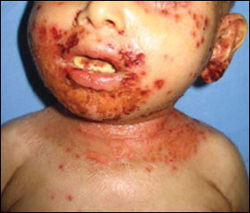|
|
Pathology definition - Eczematous dermatitis

Eczematous Dermatitis
Patient who suffer from eczematous dermatitis may present with signs and symptoms such as itchiness/pruritus, oozing, crusted and erythematous lesion. I worst case scenario, the eczematous dermatitis lesion may develop into scaly plaque.
Eczematous dermatitis has a strong association with the type IV hypersensitivity reaction known as atopic dermatitis. Besides atopic dermatitis, irritant dermatitis and contact dermatitis are part of eczematous dermatitis.
There are three different stages of eczematous dermatitis which include acute stages, subacute stages and chronic stages. Acute stage is characterized by vesicles, spongiosis( edematous fluid in the epidermis) as well as perivascular infiltration of the lymphocytes in the epidermis. Subacute stage may include the presentation of acute stage as well as chronic stage. Chronic stage consists of infiltration of the lymphocytes in the dermis, hyperkeratosis and acanthosis.
The treatments of eczematous dermatitis include, removal of precipitating factors ( drugs, chemical agent or metal such as copper or nickel ( contact dermatitis), exposure to ultraviolet lights, ) , avoiding any persistent trauma( irritant dermatitis), antihistamines as well as corticosteroids.
References
1.Streit, Markus. “Contact Dermatitis: Clinics and Pathology.” Acta Odontologica
Scandinavica 59, no. 5 (January 2001): 309–314. doi:10.1080/000163501750541183.
2.Barranco VP, and Soloman H. “ECzematous Dermatitis from Nickel.” JAMA 220, no. 9 (May 29, 1972): 1244–1244. doi:10.1001/jama.1972.03200090066016.
Patient who suffer from eczematous dermatitis may present with signs and symptoms such as itchiness/pruritus, oozing, crusted and erythematous lesion. I worst case scenario, the eczematous dermatitis lesion may develop into scaly plaque.
Eczematous dermatitis has a strong association with the type IV hypersensitivity reaction known as atopic dermatitis. Besides atopic dermatitis, irritant dermatitis and contact dermatitis are part of eczematous dermatitis.
There are three different stages of eczematous dermatitis which include acute stages, subacute stages and chronic stages. Acute stage is characterized by vesicles, spongiosis( edematous fluid in the epidermis) as well as perivascular infiltration of the lymphocytes in the epidermis. Subacute stage may include the presentation of acute stage as well as chronic stage. Chronic stage consists of infiltration of the lymphocytes in the dermis, hyperkeratosis and acanthosis.
The treatments of eczematous dermatitis include, removal of precipitating factors ( drugs, chemical agent or metal such as copper or nickel ( contact dermatitis), exposure to ultraviolet lights, ) , avoiding any persistent trauma( irritant dermatitis), antihistamines as well as corticosteroids.
References
1.Streit, Markus. “Contact Dermatitis: Clinics and Pathology.” Acta Odontologica
Scandinavica 59, no. 5 (January 2001): 309–314. doi:10.1080/000163501750541183.
2.Barranco VP, and Soloman H. “ECzematous Dermatitis from Nickel.” JAMA 220, no. 9 (May 29, 1972): 1244–1244. doi:10.1001/jama.1972.03200090066016.
